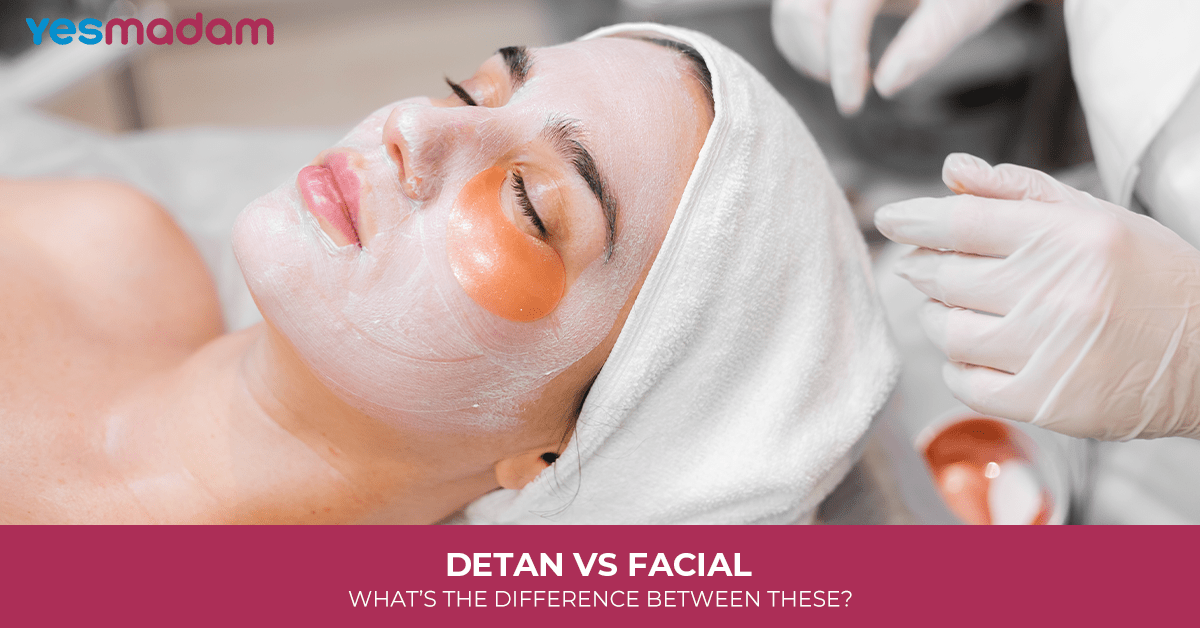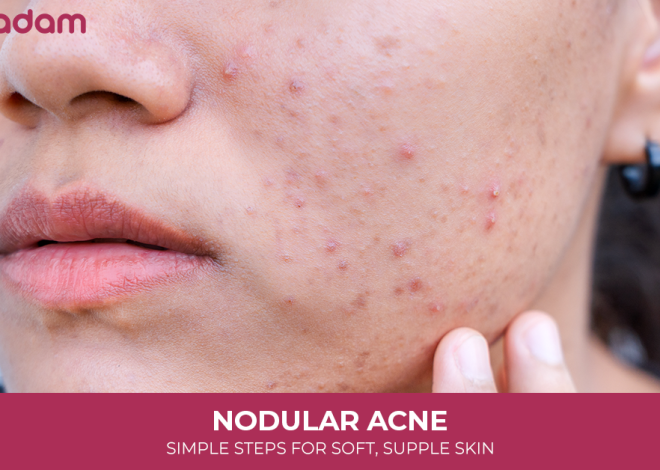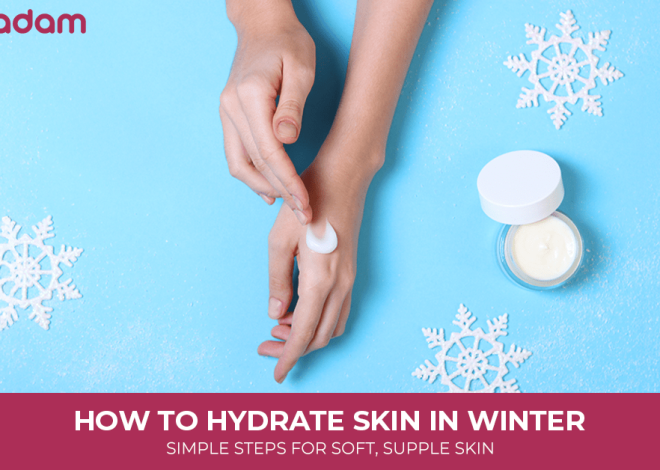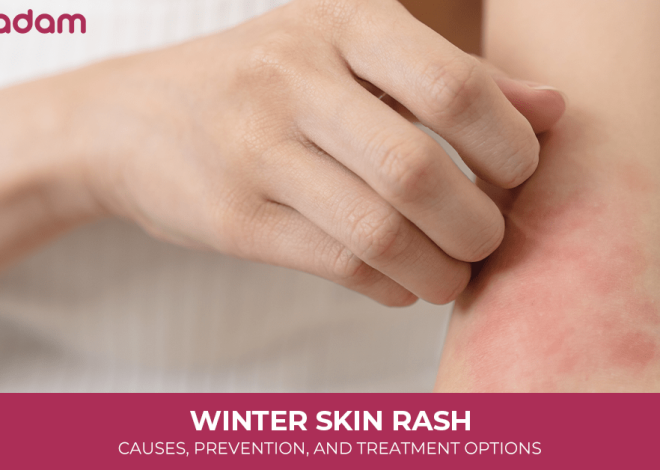
Detan vs Facial: What’s the Difference Between These?
The never-ending confusion over whether a detan or facial treatment is better for you varies as per your specific skincare concerns and needs. But choosing the right facial treatments can be tricky. Read this guide on detan vs facial to find a clear and precise answer to the most common question of whether a regular facial is enough or you should select a detan facial.
Table of Contents
What is Detan?
A detan is a type of specialized facial that helps address problems of hyperpigmentation or sun damage. It targets tan, pigmentation, and dull skin tone through deep cleansing, scrubbing, and brightening steps. It effectively removes accumulated cells and skin, which is tanned due to exposure to environmental pollution or the sun’s radiation. Detan creams and ingredients (like fruit acids, lemon extracts, and vitamin C) work to brighten the complexion and minimize the appearance of hyperpigmentation or dark spots due to sun exposure.
Step-by-Step Guide on How Detan Works

Here’s a step-by-step guide to a de-tan routine that will help you get rid of unwanted tanned skin:
Step 1:Rinse face with a powerful cleanser
Washing your face with a cleanser twice a day will help minimize dark spots, dullness, and purify your skin from within. The ideal choice should be a lemon and clay-infused face wash.
Step 2: Exfoliate dead skin with face scrub
The second step of an ideal de-tan routine should be exfoliation. It effectively removes dead skin from the face, unclogs pores, lightens skin tone, and helps reveal a smoother and fresher skin texture.
Step 3: Tightening pores with a toner
As a general rule of thumb, applying toner is important after cleansing and exfoliating your skin. As deep cleansing opens up the pores, it becomes necessary to tighten them to keep them healthy. And toner emerges as the perfect fit to do the job. A toner helps maintain a healthy skin PH level by removing impurities and skin cells from open pores.
Step 4: Applying sheet mask
A sheet mask is yet another effective step in an ideal detan routine. Charcoal sheet mask is the most popular part of the Detan skincare routine. The cleansing properties of charcoal help eliminate dead cells and provide an even skin tone.
Step 5: Hydrating skin using a moisturiser
A hydrating moisturiser is the concluding step of an effective detan routine. In the morning, as part of your AM routine, you can apply an SPF moisturiser that combines the benefits of sun protection and moisturisation in one product. During the night PM routine, apply a vitamin C-infused night cream
What is Facial?
A facial or regular facial is a more comprehensive treatment that addresses a variety of skin concerns, or simply pampers your skin to keep it clear, healthy, and hydrated. It typically includes cleansing, exfoliating, massaging, and a nourishing mask, customized as per your skin type and concerns. Unlike detan, it does not specifically address pigmentation or tan but is made to target overall skin health.
Step-by-Step Guide on How Facial Works
Here are step-by-step instructions on how to do a facial to get radiant and glowing skin :
Step 1: Client consultation
This step is similar to a pre-screening phase to determine whether a candidate is suitable for a facial in question or not.
Step 2: Pre-cleansing
Pre-cleansing helps remove a client’s makeup, oils and sebum from the face. It is crucial to prep the skin for better absorption of skincare products of facial.
Step 3: Cleansing and toning
Cleansing effectively removes all the impurities and dirt from the client’s face. This step helps in cleansing the skin without stripping off its essential and healthy oils.
Step 4: Skin Analysis
A skin analysis helps to assess the client’s problem (dehydration, sun damage, ageing, whiteheads, acne) and select the right products to be used in the later stages of facial.
Step 5: Exfoliation
Exfoliation is a method that helps slough off dead skin cells from the skin’s surface. It helps bring forth the newer skin underneath. It also helps to stimulate lymphatic drainage and improve circulation of oxygen-rich blood. Massage the exfoliating product beginning from the chest and then move upwards in circular movements.
Step 6: Extraction
The extraction process helps remove blackheads and whiteheads from the client’s face. Areas with active acne should be skipped as they may cause scarring.
Step 7: Massaging
A massage is a relaxing step after extraction. Choose the products as per the client’s skin type. Apply the products using light pressure and then massage on face, upper chest, shoulders, and neck through effleurage, petrissage, topetement, friction, and vibration movements.
Step 8: Mask
Applying a mask is a great way to finish off the facial and leave the skin refreshed. A thermal heating mask ensures the best penetration of active ingredients into the skin. It relaxes the skin and helps minimize the redness due to extraction.
Step 9: Protect using serums, toners, oils, etc
This step includes applying eye cream with tapping movements around the eyes. Then, apply serum, moisturiser, and sunscreen with SPF 30 or higher over the chest area, neck, and face.
Step 10: Completion
This step includes assisting the clients in sitting up safely. It also includes communicating with the clients, asking them about the facial experience, and giving aftercare tips.
Difference Between Detan and Facial

A detan treatment specifically targets tan and pigmentation caused by sun exposure, while a facial is a broader term encompassing various treatments for overall skin health and addressing concerns like acne, dryness, or aging.
Here’s a more detailed breakdown
De-Tan Treatment:
Focus: Primarily designed to remove tan and sun damage.
Mechanism: Uses exfoliating agents like glycolic acid, lactic acid, or salicylic acid, and sometimes includes ingredients like vitamin C or natural extracts.
Goal: Brightens the skin, reduces the appearance of dark spots and uneven skin tone caused by sun exposure.
Effect: Can provide a more even and radiant complexion, especially when dealing with sun-induced pigmentation.
Facial:
- Focus: General term for a range of treatments addressing various skin concerns.
- Mechanism: Can involve cleansing, exfoliation, massage, masks, serums, and extractions, depending on the chosen facial.
- Goal: Addresses individual skin needs like acne, dryness, aging, or dullness.
- Effect: Can improve skin texture, hydration, and overall appearance.
Key Differences:
Specificity: De-tan treatments are specific to tan removal, while facials are more general and customizable.
Targeting: De-tan treatments target melanin and dead skin cells in the deeper layers of the skin to lighten pigmentation, while facials can address a wider range of skin issues.
Ingredients: De-tan treatments often include ingredients like acids for exfoliation and brightening, while facials may include a wider range of ingredients based on the chosen treatment.
Facial vs Detan: Aftercare Do’s and Don’ts to Follow
List of Do’s and Don’ts After a Facial
| DO’s | DON’Ts |
| To keep the skin hydrated from the inside, drink a lot of water. | Do not apply makeup immediately for the rest of the day. |
| Protect your skin from the sun. Apply a broad-spectrum sunscreen with SPF 30 or higher. | Do not touch your face excessively and unnecessarily after the facial to prevent infections or breakouts. |
| Follow up with your regular skincare routine that includes cleansing , toning, and moisturising. | Avoid using harsh products or exfoliants to avoid potential irritation or damage. |
| Follow your expert’s advice for which products to use and which to avoid. | Don’t go for any laser treatment, waxing, or threading after the facial. |
List of Do’s and Don’ts after a detan procedure
| DO’s | DON’Ts |
| Communicate with your professional immediately if there is any allergy or irritation after applying any of the detan products on the skin. | Don’t step out in the sun immediately after the de-tan procedure. |
| Choose the detan products and procedure according to your skin type and budget. | Don’t compromise on cleanliness and hygiene, as it may aggravate skin conditions. |
| Be careful of what you eat and consume sufficient liquids so that the procedure continues to yield results. | Don’t expect miraculous results immediately. Expect a certain level of de-tanning through particular products. |
Conclusion
Therefore, the choice between detan vs facial ultimately depends on your personal skincare concerns and goals. If you’re looking to tackle stubborn tan lines, a detan procedure should be your go-to option. Similarly, if you want a balanced, radiant skin tone, a facial treatment may be the better choice. For high-quality and personalised results, it is important to consult with a dermatologist to help find out whether facial or de-tan is best for you.
FAQs
What is the difference between facial and De-tan?
A facial is a broader term for a multi-step skin treatment. A de-tan treatment, on the other hand, specifically targets sun-induced tan and pigmentation.
Can we do facial after detan?
Yes, you can get a facial after a de-tan treatment, but it’s generally recommended to space them out to avoid over-exfoliating or irritating the skin.
Detan or facial, which is better?
A De-Tan facial is better for removing sun tan and pigmentation, while a regular facial is good for maintaining overall skin health and addressing other concerns like dryness or dullness.
What are the best alternatives to De-tan and facial?
For effective alternatives to detan and facials, shift to natural remedies like lemon and honey, yogurt and turmeric, or cucumber and aloe vera.
How many days does De-tan vs facial last?
A detan pack usually lasts for about 7-10 days, while a facial, including a detan facial, can last for about a month.
Is Detan and facial good for the skin?
Yes, both de-tan and facial treatments are good for skin, offering different benefits. De-tan treatments focus on removing tan and brightening the skin, while facials are a more comprehensive approach to skin health.
What are the side effects of detan vs facial treatments?
De-tan treatments, especially those using harsh chemicals, may cause dryness, sensitivity to sunlight. Regular facials, while generally safe, may sometimes lead to temporary redness, breakouts due to bacteria, or dryness.
Is facial good for tan removal?
While a standard facial may not completely remove a suntan, it can help to reduce its appearance and improve overall skin health.
How often can we do a detan and regular facial?
A de-tan facial may generally be done once or twice a month for those with high sun exposure. Regular facials, which focus on overall skin health, can be done every 4-6 weeks.
How many days does facial and detan take to show results?
Although noticeable results from facials and de-tan treatments vary, you can expect to see some improvements within a few days, with more significant changes developing over a few weeks with consistent care.



